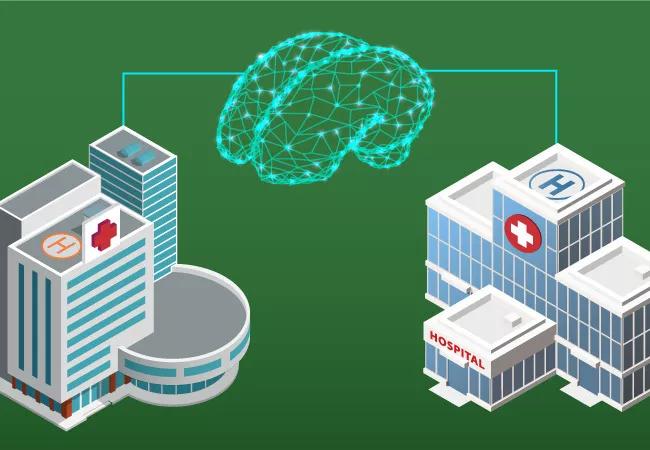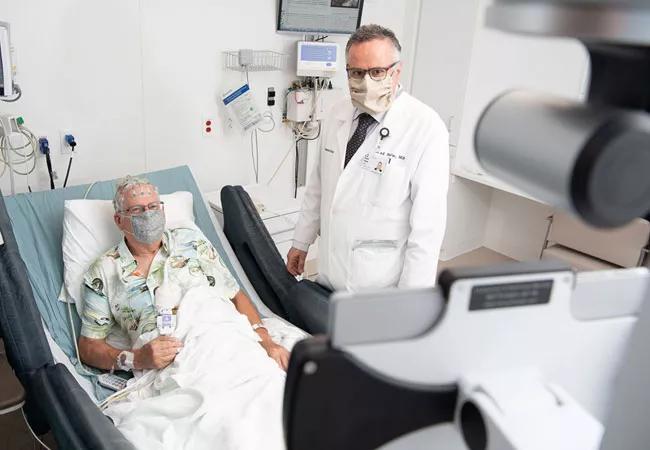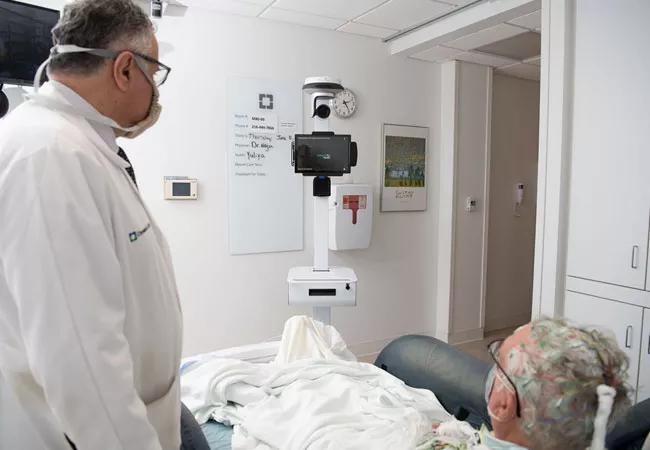Our Neurological Institute offers telemedicine relationships across multiple subspecialties

With nearly a decade of experience under its belt in offering telestroke services to external hospitals, Cleveland Clinic’s Neurological Institute is now beginning to offer similar inpatient teleneurological care in many additional subspecialty areas.
Advertisement
Cleveland Clinic is a non-profit academic medical center. Advertising on our site helps support our mission. We do not endorse non-Cleveland Clinic products or services. Policy
“There’s a serious shortage in specialty neurological care,” says Zeshaun Khawaja, MD, MBA, Cleveland Clinic’s Telestroke Medical Director, who is leading efforts around the expanded teleneurological care offerings. “Cleveland Clinic has an opportunity to use our experience in virtual health and neurology to help hospitals with unmet patient needs provide access to expert subspecialist neurological care to patients in their own communities without the need to travel long distances.”
The initiative is building on insights gleaned from the Neurological Institute’s track record in telestroke care and its more recent internal use of inpatient telemedicine technologies across a range of additional neurological subspecialties.
Since its launch in 2011, Cleveland Clinic’s Telestroke Program has completed more than 9,000 patient evaluations, directed administration of tPA to over 1,000 patients and led to more than 300 thrombectomy procedures. Today a team of 24 stroke-trained Cleveland Clinic specialists — including stroke neurologists, neurointensivists, interventional neurologists and a neurosurgeon — provide round-the-clock coverage for acute stroke care at 17 healthcare facilities inside and outside the Cleveland Clinic health system, including sites in Ohio, Florida and Pennsylvania.
“We’ve found that telestroke care has enabled us to deliver acute stroke treatment faster, safer and more often,” says Dr. Khawaja. “Our telestroke physicians can connect with hospitals within minutes to direct acute stroke care and have complete access to imaging and other pertinent patient-related information. We can respond to strokes much faster than in the past, when we would need to travel back to the hospital from home for an in-person evaluation.”
Advertisement
These gains were achieved at the same time Cleveland Clinic helped define best practices in mobile stroke treatment, deploying one of the first mobile stroke treatment units in the U.S. in 2014 and demonstrating that such units are associated with faster interventions and twice the likelihood that patients will achieve excellent or good functional outcomes.
Telestroke care delivered within the Cleveland Clinic health system often involves connecting a patient in an emergency department (ED) at a smaller regional hospital with one of the stroke-trained specialists providing telestroke coverage. In such cases, mobile videoconferencing carts are used, offering enhanced pan-and-zoom capabilities to allow the telestroke specialist to focus on areas pertinent to the stroke examination.
These carts — complete with touchscreen interface, high-definition adjustable camera and speaker/microphone — have been an important part of Cleveland Clinic’s expansion of inpatient telemedicine across its broader Neurological Institute. As detailed in a recent Consult QD post, the Neurological Institute began deploying the carts across Cleveland Clinic health system hospitals in the year or so before the advent of COVID-19 in early 2020. Most were placed in EDs, with some used to provide occasional neurologist coverage at regional hospitals. “Our goal has been to provide patients with access to Cleveland Clinic physician experts at any time, wherever they are,” notes Imad Najm, MD, Vice Chair of the Neurological Institute. “This objective predated the pandemic.”
Advertisement
But as COVID-19 began to emerge, the objective gained a broader rationale: maintaining access to care while protecting patients and providers from the bidirectional risk of virus transmission. Additional carts were purchased and deployed in sites ranging from adult and pediatric epilepsy monitoring units to neurosurgery units.
The technology allows care teams to virtually round on neurological inpatients without losing face-to-face contact. “The beauty of this approach is that it can be highly multidisciplinary,” says Dr. Najm, who is also Director of Cleveland Clinic’s Charles Shor Epilepsy Center and uses virtual rounding extensively. “We can bring together a varied team to collectively see a patient and discuss the care plan together, regardless of where the team members physically are.”


Two views of Dr. Najm and a patient interacting with other providers via a telemedicine videoconferencing cart on an inpatient neurology floor on Cleveland Clinic’s main campus.
He identifies a number of benefits for inpatient telemedicine beyond reduced risk of virus transmission:
Advertisement
It was this long-term experience with telestroke combined with broader inpatient telemedicine in the past couple of years that prompted the Neurological Institute to begin offering a menu of teleneurological services to external hospitals.
“When patients don’t have access to the type of neurological care they need, it can be a real burden, requiring costly travel or causing them to forgo needed treatment,” says Dr. Khawaja. And patients aren’t the only ones impacted. “Community hospitals may find patients are getting diverted by EMS to larger hospital systems that have regular specialty neurology coverage or invest in costly irregular coverage by locum tenens physicians,” he adds. “Telemedicine is a great solution in the right setting, but we are very cognizant that it doesn’t replace traditional neurological care in hospital or at the office. We encourage discussions with potential collaborating hospitals to see if our teleneurology offerings are the right fit. We have significant capacity to care for patients inside and outside Cleveland Clinic and are ready to establish collaborative relationships to do so using telemedicine.”
In addition to telestroke, initial service offerings will include:
Advertisement
Other offerings may follow soon. “We are working with the many centers across Cleveland Clinic’s Neurological Institute to find ways to offer high-quality and value-based neurologic specialty virtual care,” Dr. Khawaja observes.
The nature of the services offered as part of a collaborative teleneurological relationship go beyond face-to-face video consults. “Virtual health is more than a face-to-face video evaluation,” Dr. Khawaja notes. “It can include peer-to-peer discussions or participation in multidisciplinary conferences to determine candidacy for epilepsy surgery or brain tumor management. Our virtual health tools also enable us to train physicians on how to use novel devices.”
He adds that these relationships can likewise have more of an intellectual property focus, where Cleveland Clinic shares its care path or best practices for managing a particular disease state or its process for establishing, for example, an epilepsy monitoring unit or acute headache management services. Neurological Institute experts can also conduct on-site or virtual program evaluations and offer recommendations to enhance quality and performance metrics. “We are interested in working with motivated hospitals and centers to help improve patient care through efficient, value-based methods,” he says.
Regardless of the type of relationship, it is generally hardware-agnostic, as the collaborating hospital does not need to have the same model of mobile videoconferencing carts that Cleveland Clinic does for the virtual collaboration to work.
Several points of distinction about Cleveland Clinic’s Telestroke Program loom large as Dr. Khawaja and his Neurological Institute colleagues begin to broaden their teleneurological care offerings.
Some are technical, such as a homegrown logic-based navigator within the electronic health record that presents the physician with click-through response options to all questions relevant to a stroke case, from the standpoints of both patient care and quality metrics. “This has significantly improved the quality of our documentation and the speed at which it reaches our collaborating sites,” Dr. Khawaja notes. “These novel tools allow us to provide meaningful input to hospitals and ensure all pertinent metrics and calculations are clearly presented, which is critical when it comes to Joint Commission certifications.”
Other points of distinction are cultural, such as an ethos of collaboration. “We take pride in the collaborative relationship we’ve fostered with our ED physicians,” Dr. Khawaja says. “The first thing we do when working with a new site is engage all program stakeholders, including the doctors, nurses, advanced practice providers, technicians and administrators. It’s important to design a program that’s sensitive to the needs and capabilities of each site. We don’t take a cookie-cutter approach to care. We also strive to use collaboratively created protocols to drive the evaluation and other aspects of care while still ensuring that the local physician maintains control of the patient’s care.”
A similar cultural distinction involves a serious commitment to minimizing patient transfers. “One of the functions of telestroke is to determine the safest disposition for the patient,” Dr. Khawaja notes. “Prior to our telestroke capabilities, we would too often transfer patients who didn’t need it because we were working with limited information. Telemedicine allows us to evaluate patients, review their imaging and only transfer those who require advanced procedures or monitoring. It has resulted in more patients remaining within their communities, which is very important. The same principle applies to teleneurological care overall. When practiced appropriately, it keeps the patient close to home and reserves transfer for only those cases that demand testing or treatment not available locally.”
As Dr. Khawaja speaks with hospitals about forging relationships, he points out that teleneurological care is a positive development for neurology as a profession, in view of the neurologist shortage, as well as for the hospitals neurologists serve.
“Teleneurological care can be tailored to fit a hospital’s needs,” Dr. Khawaja says, noting that it introduces consistency in quality as well as coverage. “It can be very costly for community hospitals to have consistent neurological coverage. Often hospitals resort to expensive locums coverage to fill scheduling gaps. This can result in practice inconsistencies and degrade the quality of care, diminishing the experience of patients and caregivers alike. With teleneurological care, you don’t need to worry about mileage stipends, hotel accommodations and meal allowances. There can be a significant cost savings.”
He adds that teleneurology can also help manage physician burnout, especially as increases in service burdens remain in the spotlight. “Our experience with telestroke has demonstrated that providing night and weekend coverage can give neurologists a well-deserved break without compromising patient care,” Dr. Khawaja says. “Although stroke coverage can be particularly taxing due to its acute nature, the same principle applies to coverage of other specialty neurological care, both acute and nonacute. In this way, teleneurological care — when it’s done right — can be a significant asset to physicians as well as to their patients and the hospitals they serve.”
To learn more, contact Dr. Khawaja at khawajz@ccf.org and Dr. Najm at najmi@ccf.org.
Advertisement

Case study of radial-to-axillary nerve transfer for tumor-related deltoid nerve injury

An update on the technology from the busiest Gamma Knife center in the Americas

Real-time adjustments may help reduce bothersome dyskinesias

Anatomical modeling can identify optimal surgical candidates, study suggests

Add AI to the list of tools expected to advance care for pain patients

New guidelines from Brain Trauma Foundation urge early and aggressive treatment

Cleveland Clinic study investigated standard regimen

Despite the condition’s debilitating, electric shock-like pain, treatment options are better than ever